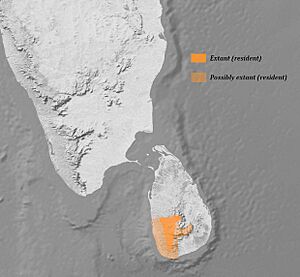Sri Lanka blue magpie facts for kids
Quick facts for kids Sri Lanka blue magpie |
|
|---|---|
 |
|
| At Sinharaja Forest Reserve, Sri Lanka | |
| Conservation status | |
| Scientific classification | |
| Genus: |
Urocissa
|
| Species: |
ornata
|
 |
|
| Distribution map for Sri Lanka Blue Magpie | |
The Sri Lanka blue magpie (also called the Ceylon magpie) is a beautiful, colorful bird found only in Sri Lanka. Its scientific name is Urocissa ornata. This bird is part of the Corvidae family, which includes crows and jays.
These magpies are very good at hunting in thick forest treetops. They are active and quick, but they don't fly long distances. Even though they can get used to people, they are considered vulnerable to extinction. This is because their home, the dense primary forest in southern Sri Lanka, is being broken up and destroyed.
Contents
What Does the Sri Lanka Blue Magpie Look Like?
The Sri Lanka blue magpie is about 42–47 cm long. This makes it bigger than a mynah bird but smaller than a crow. It has a strong beak.
Its feathers are bright blue. The head, neck, and wings are a reddish-brown color. Its long, blue tail has a white tip. The beak, legs, feet, and the skin around its eyes are all bright red. Both male and female magpies look the same.
Young magpies look similar to adults but are duller in color. Their eye rings are brown, and their blue feathers, especially underneath, have a grayish tint. These birds usually shed their old feathers and grow new ones between August and November.
Where Do Sri Lanka Blue Magpies Live?
This bird lives only in Sri Lanka. It prefers tall, untouched forests in the mountains, foothills, and nearby lowlands. You can find them from less than 150 meters up to 2150 meters high.
They usually avoid places where humans have changed the habitat, like gardens or farms. Surveys done between 2004 and 2006 found these birds in 38 different forest areas. These areas were part of six larger forest groups in the wet zone of southern Sri Lanka.
How Do Sri Lanka Blue Magpies Behave?
Even though these magpies avoid disturbed habitats, they can get used to people. They are even attracted to human visitors. When there were a few people around, the number of Sri Lanka blue magpies actually went up.
Sometimes, a group of these birds would wait near trails. They seemed to expect food from human visitors.
What Sounds Do Sri Lanka Blue Magpies Make?
Sri Lanka blue magpies make many different sounds. Some of their calls sound like a jingle, a chink-chink, a crakrakrakrak, or a whee-whee.
Scientists have found 13 common types of calls. These include calls where they copy other sounds. They often copy the calls of birds of prey, like Accipiter hawks or the mountain hawk-eagle. They usually do this when they are mobbing a predator. Another bird in the same area, the greater racket-tailed drongo, also copies these predator calls. This suggests these alarm calls can warn many different bird species.
These magpies don't just copy predator calls. They also imitate the calls and songs of other birds. They do this in their long and detailed "subsong," which is like a practice song.
What Do Sri Lanka Blue Magpies Eat?
These birds use their strong legs and feet to find food. They have been seen hanging upside down and easily holding down their prey.
Their diet is mostly meat. They eat insects, frogs, and small lizards. However, they also eat fruit. Some people have seen them eating the eggs or young of other bird species. Sri Lanka blue magpies have also been observed rubbing hairy caterpillars against mossy branches. They do this to remove the irritating hairs before eating them.
Reproduction and Life Cycle
Sri Lanka blue magpies are monogamous, meaning they have one partner. They also use co-operative breeding to raise their young. This means other birds in the group help the parents.
You can often see them in small groups of up to seven birds. Each group has its own territory. The breeding season for these magpies is from January to March. They lay three to five eggs in a clutch. The eggs are white with brown spots.
They build cup-shaped nests on top of small, thin trees. They line the nests with soft materials like lichen. Both the male and female birds help build the nest and feed the babies. However, only the female sits on the eggs to keep them warm.
Why Are Sri Lanka Blue Magpies Endangered?
The Sri Lanka blue magpie is listed as vulnerable. This is because its population is shrinking and its habitat is becoming fragmented. Surveys from 2004-2006 estimated there were about 10,181 to 19,765 individuals. However, because they are monogamous and breed cooperatively, the number of breeding individuals is lower, estimated at 9,500 to 19,500 birds.
The biggest danger to these birds is losing their home. Forests are being cut down for farms, mines, logging, and human settlements. A ban on logging in wet zones in 1990 and legal protection for this bird in Sri Lanka could help slow their decline. However, air pollution and the use of chemicals called biocides in the hill country still threaten them.
One reason these magpies might not move into disturbed areas is the presence of the Asian koel. This bird is a brood parasite, meaning it lays its eggs in the nests of other birds.
In Culture
In Sri Lanka, this bird is known as කැහිබෙල්ලා (kehibella) in the Sinhala language. The blue magpie also appeared on a 10c Sri Lankan postal stamp. This stamp was widely used in the 1980s and 1990s.


